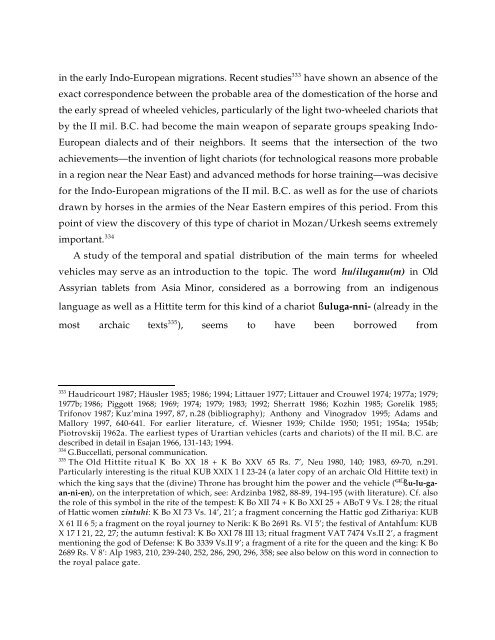Comparative Notes on Hurro-Urartian, Northern Caucasian
Comparative Notes on Hurro-Urartian, Northern Caucasian
Comparative Notes on Hurro-Urartian, Northern Caucasian
Create successful ePaper yourself
Turn your PDF publications into a flip-book with our unique Google optimized e-Paper software.
in the early Indo-European migrati<strong>on</strong>s. Recent studies 333 have shown an absence of the<br />
exact corresp<strong>on</strong>dence between the probable area of the domesticati<strong>on</strong> of the horse and<br />
the early spread of wheeled vehicles, particularly of the light two-wheeled chariots that<br />
by the II mil. B.C. had become the main weap<strong>on</strong> of separate groups speaking Indo-<br />
European dialects and of their neighbors. It seems that the intersecti<strong>on</strong> of the two<br />
achievements—the inventi<strong>on</strong> of light chariots (for technological reas<strong>on</strong>s more probable<br />
in a regi<strong>on</strong> near the Near East) and advanced methods for horse training—was decisive<br />
for the Indo-European migrati<strong>on</strong>s of the II mil. B.C. as well as for the use of chariots<br />
drawn by horses in the armies of the Near Eastern empires of this period. From this<br />
point of view the discovery of this type of chariot in Mozan/Urkesh seems extremely<br />
important. 334<br />
A study of the temporal and spatial distributi<strong>on</strong> of the main terms for wheeled<br />
vehicles may serve as an introducti<strong>on</strong> to the topic. The word hu/iluganu(m) in Old<br />
Assyrian tablets from Asia Minor, c<strong>on</strong>sidered as a borrowing from an indigenous<br />
language as well as a Hittite term for this kind of a chariot ßuluga-nni- (already in the<br />
most archaic texts 335 ), seems to have been borrowed from<br />
333 Haudricourt 1987; Häusler 1985; 1986; 1994; Littauer 1977; Littauer and Crouwel 1974; 1977a; 1979;<br />
1977b; 1986; Piggott 1968; 1969; 1974; 1979; 1983; 1992; Sherratt 1986; Kozhin 1985; Gorelik 1985;<br />
Trif<strong>on</strong>ov 1987; Kuz’mina 1997, 87, n.28 (bibliography); Anth<strong>on</strong>y and Vinogradov 1995; Adams and<br />
Mallory 1997, 640-641. For earlier literature, cf. Wiesner 1939; Childe 1950; 1951; 1954a; 1954b;<br />
Piotrovskij 1962a. The earliest types of <strong>Urartian</strong> vehicles (carts and chariots) of the II mil. B.C. are<br />
described in detail in Esajan 1966, 131-143; 1994.<br />
334 G.Buccellati, pers<strong>on</strong>al communicati<strong>on</strong>.<br />
335 The Old Hittite ritual K Bo XX 18 + K Bo XXV 65 Rs. 7’, Neu 1980, 140; 1983, 69-70, n.291.<br />
Particularly interesting is the ritual KUB XXIX 1 I 23-24 (a later copy of an archaic Old Hittite text) in<br />
which the king says that the (divine) Thr<strong>on</strong>e has brought him the power and the vehicle ( ßu-lu-gaan-ni-en),<br />
<strong>on</strong> the interpretati<strong>on</strong> of which, see: Ardzinba 1982, 88-89, 194-195 (with literature). Cf. also<br />
the role of this symbol in the rite of the tempest: K Bo XII 74 + K Bo XXI 25 + ABoT 9 Vs. I 28; the ritual<br />
of Hattic women zintuhi: K Bo XI 73 Vs. 14’, 21’; a fragment c<strong>on</strong>cerning the Hattic god Zithariya: KUB<br />
X 61 II 6 5; a fragment <strong>on</strong> the royal journey to Nerik: K Bo 2691 Rs. VI 5’; the festival of AntahÍum: KUB<br />
X 17 I 21, 22, 27; the autumn festival: K Bo XXI 78 III 13; ritual fragment VAT 7474 Vs.II 2’, a fragment<br />
menti<strong>on</strong>ing the god of Defense: K Bo 3339 Vs.II 9’; a fragment of a rite for the queen and the king: K Bo<br />
2689 Rs. V 8’: Alp 1983, 210, 239-240, 252, 286, 290, 296, 358; see also below <strong>on</strong> this word in c<strong>on</strong>necti<strong>on</strong> to<br />
the royal palace gate.





